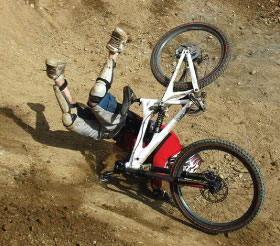Dental Implants For Teenagers
Factors Influencing Treatment Planning in Adolescents
Dear Doctor,
My 14-year-old recently went over the handlebars and lost his two front teeth. He was due to start orthodontic treatment. How will this impact his orthodontic treatment and how should we replace his missing teeth?

Dear Jessica,
Sorry to hear about the accident, but all is not lost. Here are a few major points to bear in mind.
Be Proactive
The biggest consequence of tooth loss is actually bone loss of the tooth socket. Given the recent nature of the injury and the tooth loss that resulted from it, a cone beam scan (three-dimensional x-ray) of the area is recommended to determine what damage (if any) was done to the bone as a result of the injury.
One of the best ways to ensure that the bone mass and volume are not lost is to be proactive and preserve it with a bone grafting material. Bone grafts act as scaffolds upon which your body builds bone that eventually replaces the graft. Bone grafting materials are replaced by the body at different speeds by a process known as resorption, which is dependent upon the type of graft material and the way it is manufactured and/or processed. A slowly resorbing graft may be preferred in your case.
If more severe bone loss has occurred as the result of the injury, then a total rebuilding not only of the tooth socket, but also of the underlying jaw structure and bony ridge is required.
Orthodontic Treatment — Still A Go
Your orthodontist can accommodate the loss of the two front teeth by temporarily adding them as artificial teeth, color-matched and shaped just like the ones your son lost; they can be integrated into the orthodontic appliances, either into traditional braces or clear aligners, so that he can look and function normally.
The orthodontist will be sure to maintain enough space to ultimately replace the teeth with dental implants, an important consideration. At the end of the treatment your son will undoubtedly require retainers for a period of time (or temporary bridges can be bonded to the adjacent teeth).
Dental implant systems are the best way to permanently replace missing teeth.
State-of-the-art
Dental implants are the best way to permanently replace missing teeth. Dental implants are actually tooth root replacements. The titanium of which they are made has a unique property: it fuses to bone in a process called osseointegration (“osseo” – bone; “integration” – joining with). Once this fusion has taken place, crowns — the parts of teeth that are visible in the mouth — are attached to the implants. These systems function like stand-alone teeth, which means they don't attach to or affect adjacent teeth; they don't decay, and if kept clean, they have a minimal chance of developing gum disease. Importantly, they preserve bone. When done well, they will look and function exactly like natural teeth, and nobody will be able to tell the difference.
Timing Is Everything
The last point has to do with the timing of the implants. The answer to “timing” lies in understanding how growth and development of your child's face and jaws influences the teeth, implants and jawbone. Growth in males can continue until somewhere around 20 to 23 years of age; there is actually no reliable biologic marker to tell when it is finally complete. While growing, the upper jaw tends to move in a downward and forward direction. The teeth within the upper jawbone move harmoniously with it. The problem is that dental implants attach to the bone differently than natural teeth, and if placed too early, while growth and development are continuing, the implants won't move with the jawbone. They remain stationery relative to the adjacent teeth, which actually can make them look like they're sinking into the bone below the gum line. This could create extra long-looking teeth if the implants are placed too soon.
The time sequence for your 14-year-old son requires approximately six or more years before implants could be placed and the crowns attached a few months later. And as mentioned before, dental implants will continue to stabilize, support and maintain the jawbone — and consequently the surrounding gum and facial tissues and structures.
You should consult with your dentist if you have further questions so that you can be comfortable with the game plan, and to get the team of professionals on board that you'll need to see the process through. This is a complicated situation and to have additional questions is quite normal. I'm sure your dentist will be happy to provide further clarification.
We're always telling our kids that they'll have to wait until they're a little older for some reason or other, and getting dental implants in your son's case may be one more of those times.





